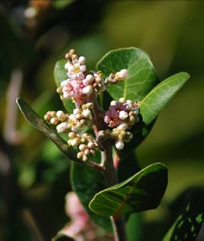Good Bets for Hedges to Replace Dying Oleanders
Mary James
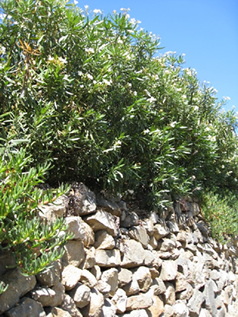
A landscape icon in San Diego and throughout Southern California, the ubiquitous oleander (Nerium oleander), is falling victim to an incurable disease.
Native to the Mediterranean region, these versatile shrubs with slender leaves and azalea-like flowers are often planted a carefree screen, defining property lines, and providing privacy or, as one gardener admitted, "separating me from the junkyard next door."
Oleanders may be shunned by some plant collectors as commonplace and by some homeowners for their toxicity - all parts of the plants are poisonous. But it's difficult to dispute their utility as so many succumb, leaving unwanted gaps in area gardens.
Two culprits
Oleander leaf scorch is the reason the leaves on these long-lived shrubs are drooping, turning brown and dying. Individual branches die back; then, as more branches are affected, the entire plant dies. As summer's heat peaks and Santa Anas roar, the demise of infected oleanders will usually accelerate. Some experts predict that more than 90 percent could die in the next few years
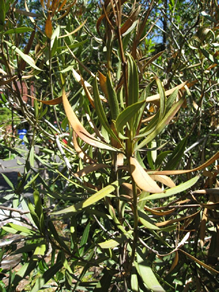 Oleander infected with Oleander Leaf Scorch. Photo by Mary James |
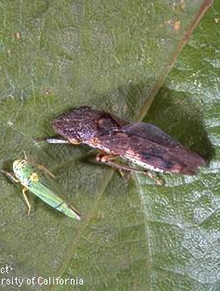 Glassy-winged (above) and blue-green sharpshooter adults To learn more about the sharpshooter and Oleander Leaf Scortch, read the UC pest note |
There are two culprits. One is a new strain of the bacterium, Xylella fastidiosa, and the second is a relatively new insect vector, the glassy-winged sharpshooter, which spreads the disease from oleander to oleander. The same species of Xylella threatens commercial crops, causing Pierce's disease in grape vines and almond leaf scorch in almond trees.
In each instance, the bacteria feed in the water-conducting tissue or xylem of the plant. As their numbers grow, the xylem is blocked, depriving the plant of water and nutrients. The disease takes its toll rapidly when the plants are stressed by heat and lack of rainfall.
The glassy-winged sharpshooter, a half-inch-long brown insect with clear wings, was brought into Southern California from the southeast United States. Biological controls help limit its population and aggressive steps are being taken to prevent its spread into central and Northern California.
Symptoms of oleander scorch were first spotted in the early 1990s in Palm Springs and Indio, in Riverside County, and Tustin in Orange County. In addition to San Diego County, Los Angeles, San Bernardino, Ventura and Santa Barbara counties have reported infected plants.
It can take three to five years from the time symptoms are spotted for an oleander to die. Cutting off affected branches may slow progress of the disease, but won't stop it.
Starting over
Luckily for San Diego gardeners, there are numerous, good options for replacing dead or dying oleanders that have been used as screens. In some cases, the oleanders' demise can be an opportunity to bring new and unusual plants to the garden that will serve the same purpose and are equally drought-tolerant.
Remove dead oleanders with caution, bearing in mind that the plants are poisonous if ingested. Keep dead leaves away from hay or other animal feed and caution children not to eat leaves or flowers. Wear gloves when handling all parts of the plant. Do not burn prunings because of fire danger and also because the smoke reportedly can cause irritation to mucus membranes.
The bacteria that causes oleander leaf scorch does not survive in the soil where the plant was growing. Thus other shrubs and trees can be planted in the same spot.
For gardeners seeking oleander substitutes, here are suggestions from four local landscape designers. Their choices are plants suited to Mediterranean climates like ours, including succulents and California natives.
Pamela Homfelt of PH Exterior Design (phexteriordesign.com). Homfelt designed the waterwise gardens surrounding the offices of the San Diego County Water Authority and the City of San Diego's Environmental Services headquarters. Both gardens are in Kearny Mesa.
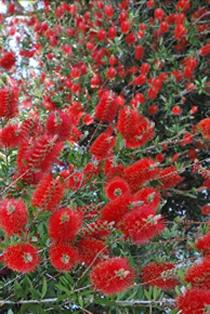 Bottlebrush. Photo by Meredith French |
- Dodonaea viscosa'Purpurea' (Purple Hop Bush) - Willowy, deep purple-bronze foliage all year; insignificant soft-pink papery flowers in late spring. Fast-growing, low water, unfussy about soil. Full sun. Grows to 20 feet tall; can be pruned shorter. Plant 5 feet on center.
- Grewia occidentalis (Lavender Starflower) - Small olive-green leaves; star-shaped lavender flowers year round. Drought tolerant at the coast; moderate water inland in warm weather. Grows to 10 feet tall. Can be sheared as hedge. Full to part sun. Plant 6 feet on center.
- Grevillea 'Long John' - Long weeping bright green leaves; dramatic orange-pink flowers winter through spring. Grows to 10 feet tall, 15 feet wide. Low water, well draining soil, avoid high phosphorus fertilizers. Full sun. Plant 8 feet on center.
- Heteromeles arbutifolia (Toyon) - Native known as California's holly. Shiny deep green leaves; red berries in winter. Grows to 15 feet tall and wide. Full sun to part shade. Moderate grower. Plant 8 feet on center.
- Elaeagnus pungens (Silverberry) - Unusual metallic silver-brown leaves; tiny fragrant flowers followed by red berries. Oleander-like shape to 7 feet tall and wide. Branches are spiny. Full sun. Tough and drought tolerant. Plant 6 feet on center.
- Callistemon citrinus (Lemon Bottlebrush) - Narrow bronze leaves mature to vivid green; dark-red "bottlebrush" flowers starting in late winter (pink and purple hybrids available). Very drought tolerant and unfussy about soil. Grows to 10 feet tall, 4-5 feet wide. Full sun. Plant 5 feet on center.\
Linda Chisari, Del Mar landscape designer (lindachisari.com)
- Podocarpus macrophyllus maki (Shrubby Yew Pine) - Tall narrow dense shrub ideal for hedge between subdivision houses. Long dark green leaves; inconspicuous flowers. Grows to 8 feet tall. Likes sun but tolerant of shade between homes. Drought tolerant. Shear to keep narrow. Plant 4 feet on center.
- Anisodontea 'Tara's Pink' and 'Elegant Lady' (Cape Mallow) - Medium green soft leaves; baby pink hibiscus-shaped flowers on 'Tara's Pink,' darker pink on 'Elegant Lady.' Can be sheared lightly. Fast growing to 6 feet tall, drought tolerant. Full sun. Plant 4 feet on center.
- Pittosporum undulatum (Victorian Box) - Glossy green leaves with wavy edges; intensely fragrant cream flowers followed by yellow-orange berries birds love. Good screen to 10 feet tall. Regular pruning controls height. Moderate water. Plant 6 feet on center.
- Thuja occidentallis 'Fastigiata' (American Arborvitae) - Tall, thin conifer thrives in coastal conditions. Evergreen yellow-green leaves resemble those of cedars. Grows to 25 feet tall; can be sheared. Low water; full sun. Plant 4 feet on center.
- Feijoa sellowiana (Pineapple Guava) - Gleaming gray-green leaves are silvery beneath; edible white flowers with red stamens are followed by delicious fruit. Very drought tolerant. Grows to 12 feet tall. Full sun. Plant 8 feet on center.
- Rhaphiolepsis 'Majestic Beauty' (Indian Hawthorn) and Rhaphiolepsis umbellata (Yeddo Hawthorn) - Familiar shrubs for carefree screens. 'Majestic Beauty' grows to 10 feet tall and has leathery dark green leaves and deep pink flowers in spring. R. umbellata reaches 8 feet tall and bears white flowers with red stamens off and on all year. Both are vigorous, drought tolerant and pest free. Full sun to part shade. Plant 4-5 feet on center.
Kay Stewart, San Diego landscape architect who specializes in native plant gardens.
|
|
- Dendromecon harfordii (Island Bush Poppy) - Best native substitute for oleander-size informal screen. Waxy grey-green foliage; many months of buttery yellow flowers. Grows up to 25 feet tall and wide; generally smaller in cultivation. Drought tolerant; avoid excess water and summer water. Take care not to damage to roots when planting. Plant 7-plus feet on center.
- Rhus integrifolia (Lemonade berry) and Rhus ovata (Sugar Bush) - Leathery dark green; pink flowers in February through April are followed by red berries. Use lemonade berry in coastal areas; sugar bush in hotter inland regions. Grow 8-10 feet tall; prune after berries form so next year's buds are not harmed. Take shearing well if you need to shape the to fit a 3-foot wide strip. Long lived. Tolerate salt air. Plant 7-plus on center.
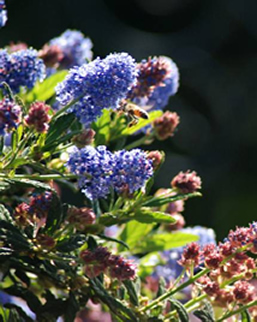 Ceanothus in bloom. Photo by Meredith French |
- Ceanothus (Wild Lilac) - Tall Ceanothus arboreus and the hybrids 'Ray Hartmann,' 'Owlswood Blue,' and 'Sierra Blue' form big barrier hedges or screens fast. C. arboreus can grow 20 feet tall; the hybrids, 12-15 feet. Flowers in shades of blue appear in March and May above shiny dark green leaves. Shed previous year's leaves as new ones emerge; excess water kills the plants. Doesn't like pruning of large branches so use where 6 foot-width is not a problem. Plant 7-plus feet on center.
- Rhamnus californica (Coffeeberry) - Neat, tidy, sturdy and dense in mass plantings. Dark green foliage; small flowers in spring are followed by marble-sized berries in shades of lime green, rose and red that ripen to black. Site where berry drop is not a problem, though birds may eat most. Grows to 15 feet tall in deep shade; takes well to pruning and shaping. Full sun or shade. Grows fast in well-drained soil; slower in clay. Do not over water. Plant 7-plus on center.
Debra Lee Baldwin, author of "Designing with Succulents" (Timber Press, 2007) and "Succulent Container Gardens" (Timber Press, January 2010).
- Aloe arborescens - Easily grown from cuttings to form a dense shrub with spiny-edged fleshy leaves that form wavy rosettes. Blooms in January with orange-red flower spikes. Grows slowly to 3-4 feet tall and wide. Keep soil moist until established; then will survive on winter rains. Good fire barrier. Needs good drainage. Tolerates some shade. Frost sensitive. Plant cuttings so they touch.
- Portulacaria afra (Elephant's Food) - Wiry adobe-brown stems hold tiny jade plant-like leaves. Fast growing to form informal hedge to 5 feet tall. Be sure to use upright, not prostrate form. Good companion with other succulents for a mixed screen. Sun or shade. Plant two feet on center.
- Crassula ovata (Jade Plant) - Easy to grow from cuttings to form shrub 3-4 feet tall and wide. Snow-white flowers in winter rise above glossy green leaves. Foliage of C. o. 'Hummel's Sunset' is yellow tinged with green and red when planted in full sun. Provide good drainage and protect from severe heat and cold. Plant 2-3 feet on center.
- Euphorbia milii (Crown of Thorns) - Mounding shrub with sparse light green leaves and flowers in warm hues ranging from reds to golds. Blooms much of the year. Branches are lined with long thorns; serves as security barrier. Species grows 3-4 feet tall, 3 feet wide over time; hybrids may be smaller. Frost sensitive. Plant 2-3 feet on center.
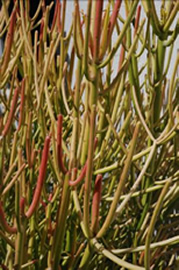 'Sticks on Fire' Pencil Tree. Photo by Meredith French |
- Euphorbia tirucalli (Pencil Tree) - Tall thin tree with pencil-thin branches, easily grown from cuttings. No thorns, but milky sap is irritating to eyes and skin. Grows 6-8 feet tall, 3 feet wide. Choice selection is 'Sticks on Fire' with branches in bonfire hues of red, pink and salmon. Tolerant of salt air. Frost sensitive. Plant 2 feet on center.
- Opuntia 'Burbank Spineless' - A selection of the shrubby cactus with broad pads that is nearly thornless. Orange-yellow flowers are followed by pear-shaped fruits. Won't form dense hedge; good backdrop at property edge. Fire resistant. Grows 8 feet tall and wide. Can be under planted with other drought-tolerant plants. Plant 4-5 feet on center.


